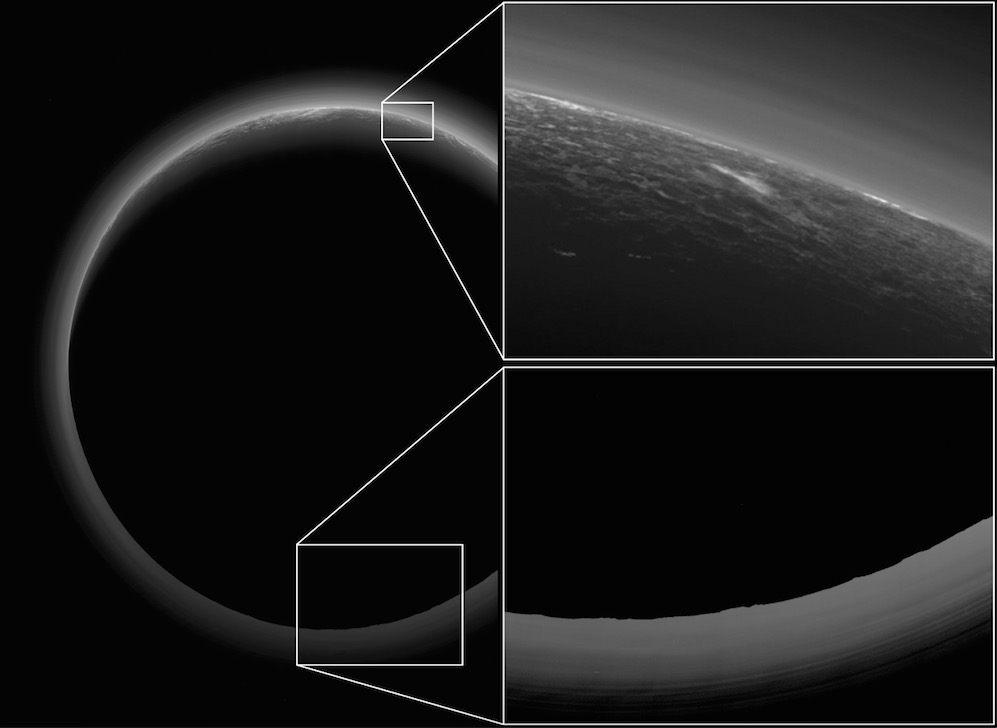Gorgeous 'Twilight Zone' Photo of Pluto May Show Cloud for 1st Time

A spectacular new image of Pluto shows rugged mountains, nitrogen-ice plains and, perhaps, a big cloud scudding through the dwarf planet's exotic skies. NASA even described the view as the "twilight zone" of Pluto.
NASA's New Horizons spacecraft captured the photo shortly after its closest approach to Pluto on July 14, 2015, when the sun was on the other side of the dwarf planet from the probe's perspective.
In the backlit twilight view, sunlight filters through Pluto's many-layered atmosphere and lights up certain features, including the towering Norgay Montes mountain range and the vast plain known as Sputnik Planum, whose surface is likely renewed every 500,000 years or so by churning convective processes.
Also illuminated is a bright wisp tens of miles across "that may be a discrete, low-lying cloud in Pluto's atmosphere; if so, it would be the only one yet identified in New Horizons imagery," NASA officials wrote in a photo description Thursday (June 2) that dubbed the image Pluto's "twilight zone." "Atmospheric models suggest that methane clouds can occasionally form in Pluto's atmosphere."
These features — mountains, plains and possible cloud — all lie in a sliver of sunlight, at the top limb of Pluto. But intriguing landscape details are also visible near the bottom of the photo, which depicts Pluto's night side.
"The topography here appears quite rugged, and broad valleys and sharp peaks with relief totaling 3 miles (5 kilometers) are apparent," NASA officials wrote.
New Horizons took the newly released photo with its Ralph/Multispectral Visual Imaging Camera about 19 minutes after closest Pluto approach, from a distance of about 13,400 miles (21,550 km). (Closest approach brought the probe within 7,800 miles, or 12,550 km, of the dwarf planet's surface.)
Breaking space news, the latest updates on rocket launches, skywatching events and more!
The photo features a resolution of about 1,400 feet (430 meters) per pixel, NASA officials said.
New Horizons is still beaming flyby data home, and will continue to do so through this coming fall. (The probe is currently about 3.2 billion miles, or 5.15 billion km, from Earth; such a vast distance makes transmission rates slow, due to the significant weakening of New Horizons' radio signal.)
The spacecraft is currently zooming toward a small object called 2014 MU69, which lies about 1 billion miles (1.6 billion km) beyond Pluto. If NASA approves and funds a proposed extended mission, New Horizons will study 2014 MU69 up close on Jan. 1, 2019.
Follow Mike Wall on Twitter @michaeldwall and Google+. Follow us @Spacedotcom, Facebook or Google+. Originally published on Space.com.

Michael Wall is a Senior Space Writer with Space.com and joined the team in 2010. He primarily covers exoplanets, spaceflight and military space, but has been known to dabble in the space art beat. His book about the search for alien life, "Out There," was published on Nov. 13, 2018. Before becoming a science writer, Michael worked as a herpetologist and wildlife biologist. He has a Ph.D. in evolutionary biology from the University of Sydney, Australia, a bachelor's degree from the University of Arizona, and a graduate certificate in science writing from the University of California, Santa Cruz. To find out what his latest project is, you can follow Michael on Twitter.

